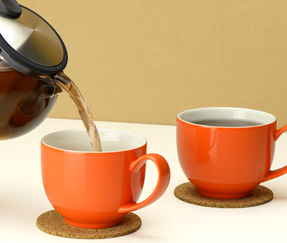
Steeping Tea
We want your cup of Mimi’s Teas premium loose leaf tea to be delicious so we provide steeping directions on every package of tea you buy from our shoppe. This includes our recommendations of quantity of tea to use, water temperature, and steep time.
Tea preparation is both objective and subjective. Your preference may change from time to time and tea to tea. Learning how to steep each tea successfully is part of the fun of tea drinking and is uniquely personal. Until I am familiar with a particular type of tea, I steep it according to recommended steeping guidelines. From that standard I make adjustments and see if I like it. I suggest this practice for all of our customers as well.
Ultimately, however, your cup of tea is your cup of tea; and you should enjoy it the way you choose to prepare it.
THE THREE MOST IMPORTANT VARIABLES WHEN STEEPING TEA; amount of leaf, water temperature, and steeping time
Variable #1: Measuring the leaf
A delicious tasting cup of tea uses neither too much nor too little leaf. There is no good reason to use more leaf than you need, although we think it is much worse to use too little and end up with a flavor-less cup.
The goal in preparing a delicious cup of tea is to have the water extract the proper balance of soluble solids (amino acids, tannins, alkaloids, and volatile compounds, plus vitamins and minerals ) from the leaf into the cup. We think that the most accurate way to ensure a tasty cup of tea each and every time you steep your tea is to use an inexpensive electronic kitchen gram scale (approximately $16.00-$35.00 cost).
For most teas our suggested measure is: 3 grams of leaf per 8 ounces of water for every 8-ounces of capacity in your teapot or steeping cup. Depending on whether your tea is small leaf, medium or large leaf, a measure of 3 grams may be 1 teaspoon, 2 teaspoons or 1-2 tablespoons.
If you are measuring your loose-leaf tea by volume (teaspoons, etc.) rather than by weight (grams) you will notice that the volume of leaf differs from tea to tea. A pound always weighs a pound, but the volume of a pound can vary dramatically – think of the difference in volume between a pound of nails and a pound of feathers. Tea also fits this example. Some teas are light and fluffy while other teas are small and dense. The volume of any tea is related to the density of the leaf.
When using our recommended 3 grams of leaf, you will notice that this measure will be a greater volume of leaf when the leaf is large (bulky whole leaves or buds) than it is when the leaf is small (tiny leaves, CTC, broken leaf, etc). Awareness of this weight-to-volume ratio will ensure that you will be able to steep every tea you encounter easily and with delicious results.
A good rule of thumb is that 1 ounce of loose-leaf tea (of any leaf-size or shape), portioned into 2-3 gram measures, will yield 12 – 15 measures of tea, enough to steep 12 – 15 six – eight ounce cups of tea. Some types of loose-leaf tea can be re-steeped several times which will increase the number of cups of tea obtained from the same ounce quantity of tea.
Variable #2: Water temperature
Water is a friend of tea, and as such, water temperature is the second most critical factor in extracting the best flavor from your tea leaves.
Different teas will deliver the best flavors and aromas when steeped with lower water temperatures than what is used for other teas. So it is advisable to pay attention to using water that is at the appropriate temperature for the type of tea that you are steeping and not TOO HOT.
Most tea leaves (even black tea) do not like to be blasted with boiling hot water, and more delicate grades of tea such as green and white teas can easily be scorched. To avoid over-extracting the flavor components of the leaf, it is better to steep the leaves slightly longer at a cooler temperature than with water that is too hot
Variable #3: Steeping time
After measurement and water temperature, the final variable is the length of time the leaf is steeped. Tea that is either under-steeped or over-steeped is disappointing. Each type of tea has a steeping time to which it responds best. By paying attention to this third element of good tea steeping practices, you will ensure a better tasting cup of tea.
In general, when steeping teas Western-style the following guidelines can be followed:
- black teas prefer steep times of 3-5 minutes
- green, white, and yellow teas prefer short steep times of 2-3 minutes
- oolong teas typically prefer steep times of 4-5 minutes.
- Pu-erh tea prefers steep times of 3-4 minutes